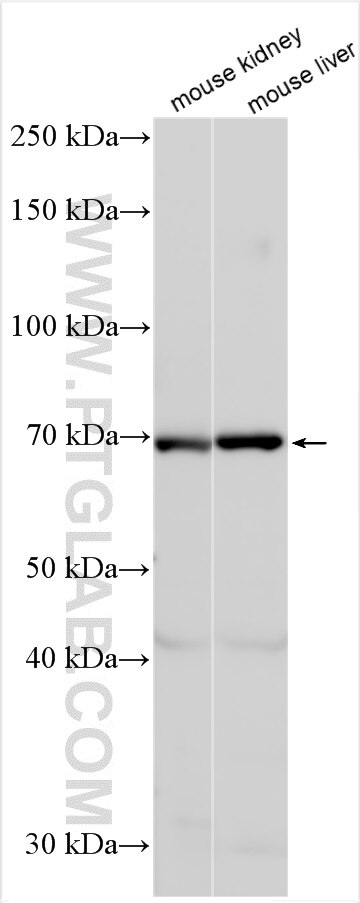OAT3/SLC22A8 Polyclonal antibody
OAT3/SLC22A8 Polyclonal Antibody for WB, ELISA
Host / Isotype
Rabbit / IgG
Reactivity
human, mouse
Applications
WB, ELISA
Conjugate
Unconjugated
Cat no : 16844-1-AP
Synonyms
Validation Data Gallery
Tested Applications
| Positive WB detected in | mouse kidney tissue, mouse liver tissue |
Recommended dilution
| Application | Dilution |
|---|---|
| Western Blot (WB) | WB : 1:1000-1:6000 |
| It is recommended that this reagent should be titrated in each testing system to obtain optimal results. | |
| Sample-dependent, Check data in validation data gallery. | |
Product Information
16844-1-AP targets OAT3/SLC22A8 in WB, ELISA applications and shows reactivity with human, mouse samples.
| Tested Reactivity | human, mouse |
| Host / Isotype | Rabbit / IgG |
| Class | Polyclonal |
| Type | Antibody |
| Immunogen | OAT3/SLC22A8 fusion protein Ag9795 |
| Full Name | solute carrier family 22 (organic anion transporter), member 8 |
| Calculated Molecular Weight | 542 aa, 60 kDa |
| Observed Molecular Weight | 70 kDa |
| GenBank Accession Number | bc022387 |
| Gene Symbol | SLC22A8 |
| Gene ID (NCBI) | 9376 |
| Conjugate | Unconjugated |
| Form | Liquid |
| Purification Method | Antigen affinity purification |
| Storage Buffer | PBS with 0.02% sodium azide and 50% glycerol pH 7.3. |
| Storage Conditions | Store at -20°C. Stable for one year after shipment. Aliquoting is unnecessary for -20oC storage. 20ul sizes contain 0.1% BSA. |
Background Information
OAT3 (encoded by SLC22A8) is widely distributed in the kidney, liver, choroid plexus, olfactory mucosa, brain, retina, and placenta, but it is pre-dominantly expressed on the basolateral membrane of renal tubular cells. OAT3 plays a crucial role in the uptake, distribution, and excretion of various endogenous/exogenous substances. 16844-1-AP detected ~70 kDa is greater than predicted for Oat3 protein containing 542 amino acid (calculated Mr 59 kDa) and probably represents the glycosylated form (PMID:23389457).
Protocols
| Product Specific Protocols | |
|---|---|
| WB protocol for OAT3/SLC22A8 antibody 16844-1-AP | Download protocol |
| Standard Protocols | |
|---|---|
| Click here to view our Standard Protocols |


